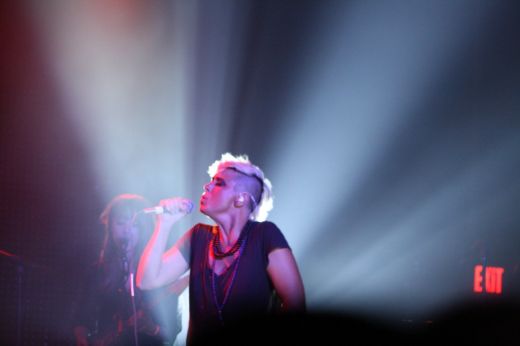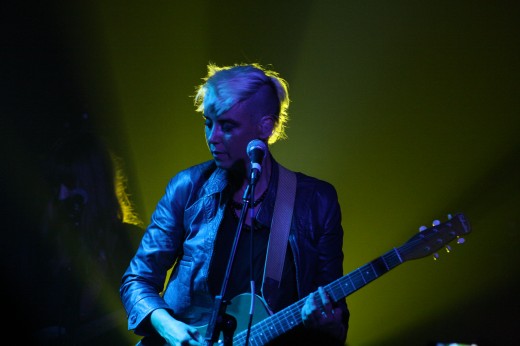Cat Power and the Tortured Artist Mystique
Jeremy Adams

Cat Power performing at Grand Central Miami this October. Photo by Alex Privee.
Fortunately, it was the former, as the off-kilter guitar jingle of “Cherokee” started crackling through the speakers. Ms. Power (real name: Chan Marshall) flashed a smile at the crowd’s initial reaction to the song—the first single from Sun, her first album of original material in over six years—but quickly isolated herself into a corner stage-left, turning away from the audience and working her body into a 90-degree “L” shape. Occasionally, she’d stand upright in a pose of self-assurance, but those moments alternated with periods of extreme nervousness: restlessly pulling her left hand in and out of her pants’ pocket, obsessively adjusting her bra, and muttering unintelligibly into the microphone.
Given Cat Power’s history of drug and alcohol abuse, the psychotic break she suffered prior to her last major tour (supporting the 2006 album The Greatest), and, of course, the famously erratic live performances, the scene at Grand Central wasn’t really a surprise, but I was still caught off-guard by the remorseless, frothing-at-the-mouth reaction of the fans. “She’s nuts!” squealed one concertgoer to my right, his eyes peeled widely as he picked apart her every move onstage. “Play ‘Ruin!’ ‘Ruin!’ I don’t know what I’m gonna do if they don’t play fucking ‘Ruin,’” vented another drunk male fan behind me, referring to one of the featured songs off Marshall’s latest disc. Meanwhile, the object of his exhortation showed signs of officially unraveling: a Milli Vanilli-type glitch on the pre-recorded backing track, overused throughout the performance—likely to protect against the sort of meltdown it was now creating—caused Marshall to grow increasingly agitated. Her indecipherable muttering turned into blurts of anger directed toward the sound tech and herself.

I thought of others, too. I thought of one of Smith’s predecessors, ‘70s British folkie Nick Drake, best known today for the Volkswagen Cabrio ad featuring his iconic “Pink Moon,” who overdosed on antidepressants. I thought of one of Smith’s little-known successors, the falsetto-voiced Jeff Hanson, who was found dead at age 31 after a drug-induced fall in his St. Paul, Minnesota apartment. I thought of the king of angst-ridden, suicidal singers, Kurt Cobain, about whom Cat Power herself wrote a song, “I Don’t Blame You.” I thought of Joplin and Springfield and Winehouse, and as I listened to Marshall, whose throaty, weathered tenor belongs with those ladies’ in the canon of great female rock vocalists, I wondered why we listen. Why should the suffering of these artists hold such mystique? Why were the kids at Grand Central waiting with bated breath for a disaster? Is it because the more brilliant creators are the ones who really agonize over their craft? If that’s the case, I say baloney. Behind the aura forged around each troubled musician lies a human being in pain, and, at least on this night, the resulting experience felt something more like schadenfreude.
In a 2011 Canadian television interview, Wilco’s Jeff Tweedy called the idea of the tortured artist a “damaging mythology,” one that has been developed around art’s twisted misbranding as a “product of pain.” The alt-rocker is often associated with his battles against chronic migraines, anxiety, and a painkiller addiction, but Tweedy doesn’t believe those struggles should define his work. “I look at it like the part of me that was able to create, managed to create in spite of the problems that I was having … almost as if that was the only healthy part of me,” he explains. Yet, what do audiences focus on when they think of van Gogh? The ear. Virginia Woolf? The madness. Hank Williams? The drinking. It’s time to shift the focus. Our current culture is certainly tabloid-driven and catastrophe-obsessed (just turn on the news), but Cat Power’s shaky visage reminded me of its equally fragile underpinnings.
Toward the second half of her set, Marshall called an audible and asked the band to skip over planned performances of older cuts from The Greatest and the 2003 album You Are Free, including “Blame.” She requested that the venue’s technicians kill the multicolored lights on stage and, instead, turn on the floodlights over the crowd. Suddenly, roles were reversed; Marshall jumped giddily at the opportunity. “This is the part where I collapse on the floor,” she explained slowly. “This is the part where I collapse onstage, and I’m crazy, and it’s a train wreck,” she repeated. Audience members blinked their eyes and shifted around uneasily. After a few minutes, once order and proper illumination had been restored, Cat Power launched into a performance of the epic sing-along “Nothin’ But Time,” featuring the heartfelt lyric: “I see you, kid, alone in your room / You got the world on your mind and you’re trying to get by / But you’ve got nothin’ but time / And it ain’t got nothin’ on you.” In the frenzy of music and lights, Marshall’s madness had somehow become our own, and now she was comforting us.










